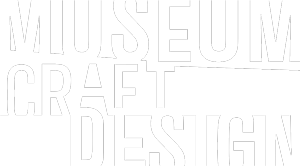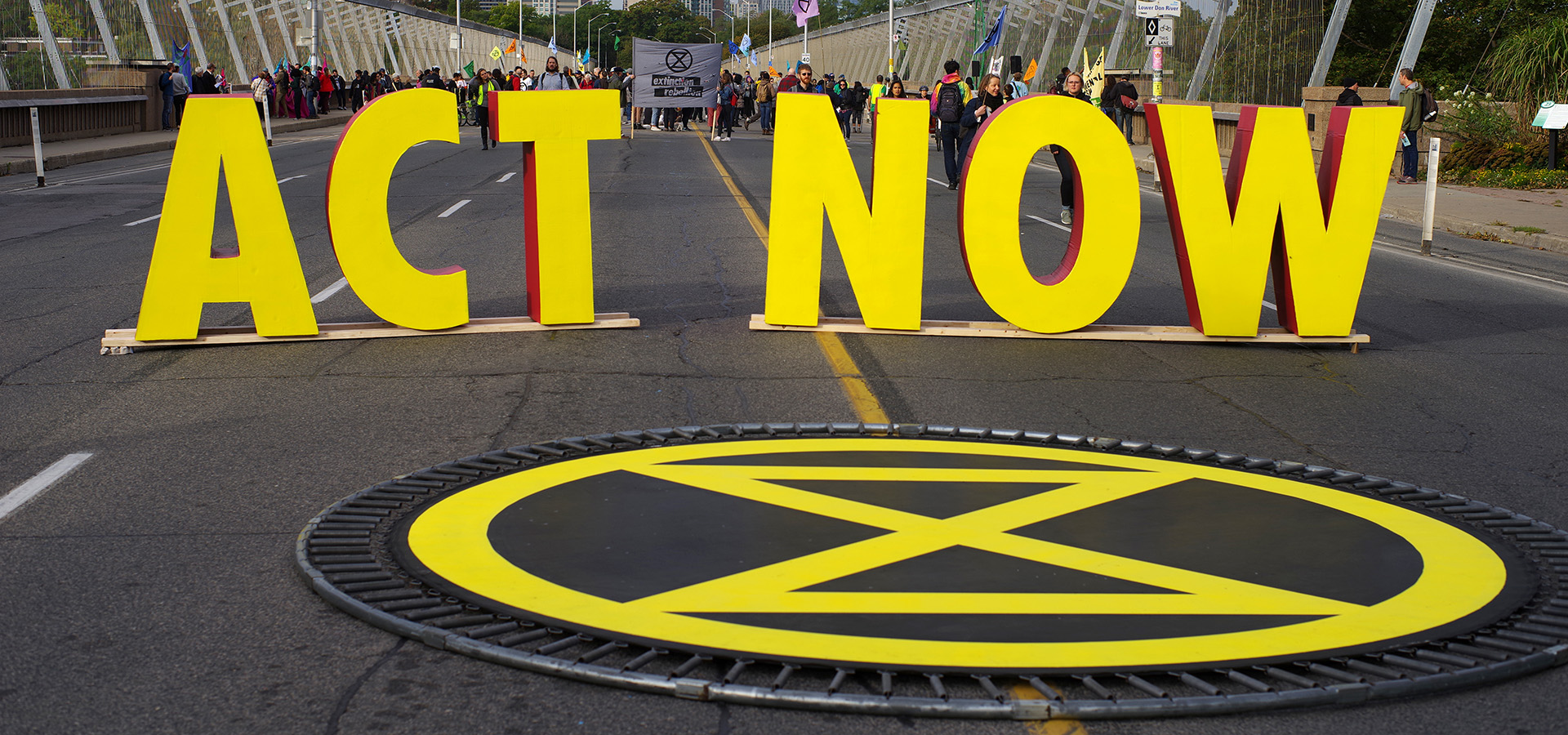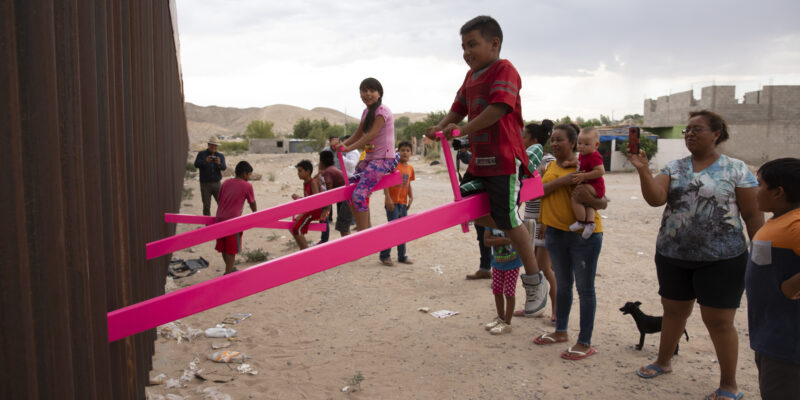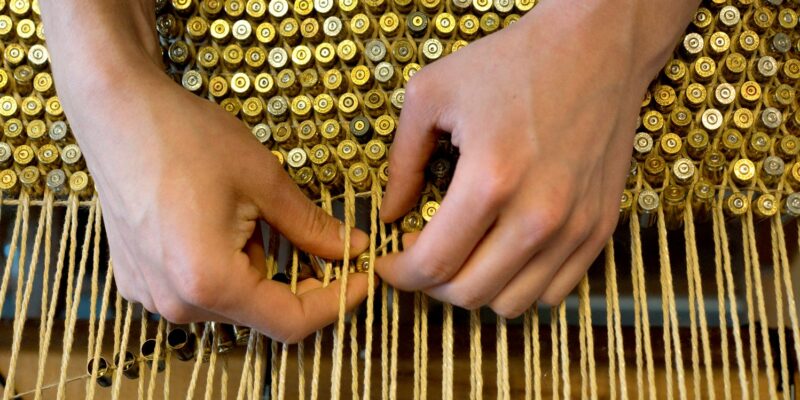San Francisco (July 12, 2023)–The Museum of Craft and Design is pleased to announce the West Coast premiere of Designing Peace, on view October 7, 2023–February 4, 2024, an exhibition organized by Cooper Hewitt, Smithsonian Design Museum that explores the unique role design can play in pursuing peace. This exhibition features design projects from around the world that look at ways to create and sustain more durable peaceful interactions—from creative confrontations that challenge existing structures to designs that demand embracing justice and truth in a search for reconciliation.
Designing Peace comes at a critical juncture of current global dynamics, with people facing vast social, environmental and economic inequities, and dozens of continuing conflicts from internal insurgencies, long-standing armed standoffs, territorial disputes, and, most recently, the Russia-Ukraine war. The exhibition considers what might be possible if society were to design for peace and takes into account goal 16 of the United Nations’ Sustainable Development Goals, which calls directly for peace, justice, and strong institutions through the elimination of hunger and poverty, improvements in health and education, the building of more resilient cities and infrastructure, the fostering of innovation, action on climate change, and more.
 Teeter-Totter Wall. Rael San Fratello and Collectivo Chopeke. Location: border at Anapra, Chihuahua, Mexico;
Teeter-Totter Wall. Rael San Fratello and Collectivo Chopeke. Location: border at Anapra, Chihuahua, Mexico;
Sunland Park, New Mexico, USA, 2019. Photo credit: Ronald Rael and Virginia San Fratello.
Designing Peace will feature approximately 30 of the original selected design proposals, initiatives, and interventions from over 20 countries, represented by objects, models, full-size installations, maps, images, and film. The exhibition showcases a wide range of design responses to the underlying reasons for conflict and division, such as socioeconomic inequality, resource competition, and environmental degradation. These responses will be sorted by the following prompts:
How can design engage creative confrontation?
How can design address the root causes of conflict?
How can design support safe, healthy, respectful environments?
How can design embrace truth and dignity in a search for peace and justice?
How can design help transitions from instability to peace?
Responses include Rael San Fratello’s Teeter-Totter Wall which originally featured three pink seesaws installed through the slats of the towering steel US-Mexico border wall. Rael San Fratello’s project demonstrates the delicate balance between the two nations and shows how movements and actions taken on one side of the border directly impact the other. In Designing Peace, the project is represented by one of the seesaws as well as prints exploring the design.

Maps (Bullet Rug Series). DETEXT. 2013-present. Photo credit: Rodrigo Pereda.
DETEXT’s Maps (Bullet Rug Series) weaves together discarded bullet casings collected in Colombia, Guatemala, Lebanon, Mexico, Spain, and the United States to create a shimmering rug that tells hidden stories of international arms trafficking. Another poignant work is HarassMap, a video installation of a crowd-mapped anonymous data reporting platform, designed by four women who were experiencing daily sexual harassment on Egypt’s streets.
MCD’s Executive Director, JoAnn Edwards, comments, “This timely exhibition spotlights the positive influence design can have in facilitating peace and how designer’s and maker’s creative responses and interventions are crucial in keeping these relevant conversations at the forefront. Design-based solutions like the ones being presented in Designing Peace carve out space for meaningful dialogue.”
Participating Designers, Artists, and Organizations:
Abir Guesmi, Amijai Benderski, Ann Salerno, Art the Arms Fair Collective, Alia Soliman, Ayako Maruyama, Bryan C. Lee, Jr., Bureau d’Études, Center for Strategic and International Studies, Chris Daemmrich, Christopher Kosek, Cindy Chen, City of New York Department of Transportation, Collaborative Architecture, Colloqate Design, Confederation of Independent Football Associations, Design Studio for Social Intervention, DETEXT, Eastern Congo Initiative, Engy Ghozlan, ESP, Hadeer Mohamed, HarassMap, Harlem Park to Park, Hood Design Studio, Institute for Economics and Peace, Jan Kristian Strømsnes, Jiawen Chen, Justin Kiggins, Kate Davies, Keit Kollo, Kim Albrecht, Lab 619, LeRone Wilson, Lesvos Solidarity, Liam Young, Lina Ghotmeh—Architecture, Lucas Pope, Manuela Aguirre, Masimran Singh, Max Phillips, Moez Tabia, MullenLowe SSP3, MUST Urbanism, New Orleans residents, Parents of former child combatants, PeaceTech Lab, Phillipe Starck, Rael San Fratello, Raúl Martínez, Rebecca Chiao, RefAid, Ronald Rael, Rosana Malaneschii, Sawsan Gad, Shelley Taylor, Shepard Fairey, Soledad Boyd, Stephen Larrick, Tristan Oliver, Unknown Fields, Valerie Wilson, Virginia San Fratello, War Boutique, World Agroforestry, and Yabel Guerra.
Designing Peace was organized by Cooper Hewitt, Smithsonian Design Museum.
This exhibition was curated by Cynthia E. Smith, Curator of Socially Responsible Design, with Caroline O’Connell, Curatorial Assistant.
A companion to the exhibition, Designing Peace: Building a Better Future Now offers perspectives on peace from activists, scholars, architects, policymakers, and graphic, game, and landscape designers. Through essays, interviews, critical maps, project profiles, data visualizations, and art, this publication conveys the momentum that design can generate in effecting a peace-filled future.
Exhibition Media Partners: Dezeen and KQED.
The Museum of Craft and Design’s exhibitions and programs are generously supported by Anonymous, the Windgate Foundation, and Grants for the Arts.
Top Image: Extinction Symbol. ESP. Location: Global, 2011-present. Photo credit: © Martin Reis
###
To RSVP for the press preview, schedule a private tour, interview requests, or for more information, contact Sarah Beth Rosales, Marketing and Communication Director, Museum of Craft and Design at sbrosales@sfmcd.org or 415.773.0303.
About Cooper Hewitt, Smithsonian Design Museum
Cooper Hewitt is America’s design museum. Inclusive, innovative, and experimental, the museum’s dynamic exhibitions, education programs, master’s program, publications, and online resources inspire, educate and empower people through design. An integral part of the Smithsonian Institution—the world’s largest museum, education, and research complex—Cooper Hewitt is located on New York City’s Museum Mile in the landmarked Carnegie Mansion. Steward of one of the world’s most diverse and comprehensive design collections—over 215,000 objects that range from an ancient Egyptian faience cup dating to about 1100 BC to contemporary 3D-printed objects and digital code—Cooper Hewitt welcomes everyone to discover the importance of design and its power to change the world. For more information, visit www.cooperhewitt.org or follow @cooperhewitt on Instagram, Facebook, Twitter, and YouTube.
About the Museum of Craft and Design
The Museum of Craft and Design (MCD) is San Francisco’s only museum devoted to craft and design. Founded in 2004, MCD showcases designers, makers, and artists through an exciting and distinctive series of craft and design-focused exhibitions and public programs. MCD explores the creative process and current perspectives in craft and design through inspired exhibitions and experiential programs. Learn more at sfmcd.org.



 Teeter-Totter Wall. Rael San Fratello and Collectivo Chopeke. Location: border at Anapra, Chihuahua, Mexico;
Teeter-Totter Wall. Rael San Fratello and Collectivo Chopeke. Location: border at Anapra, Chihuahua, Mexico;



